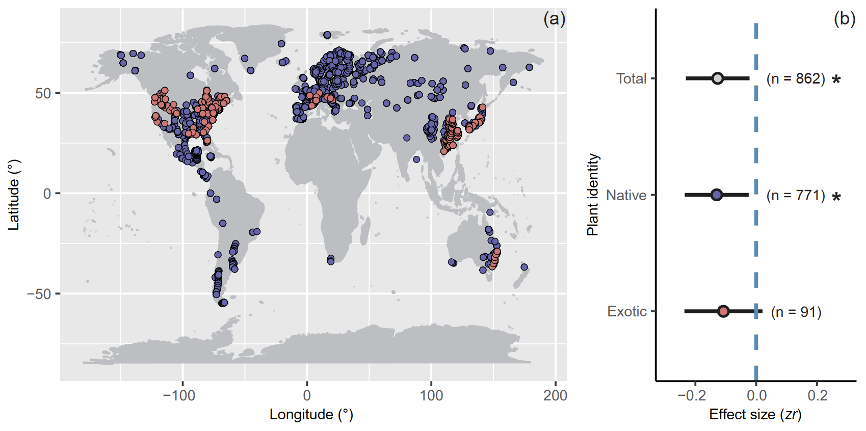Yaolin Guo1,2, Madalin Perapa2, Rui-Ting Ju1, Oliver Bossdorf2
1 Ministry of Education Key Laboratory for Biodiversity Science and Ecological Engineering, National Observations and Research Station for Wetland Ecosystems of the Yangtze Estuary, Institute of Biodiversity Science and Institute of Eco-Chongming, School of Life Sciences, Fudan University, Shanghai, China
2 Plant Evolutionary Ecology, Institute of Evolution and Ecology, University of Tübingen, Tübingen, Germany
Abstract
Latitudinal gradient of herbivory that differs between native and exotic plants has been an open issue. It is expected that a latitudinal gradient of herbivory will be evident for native plants; this gradient in exotic plants may lag behind native plants in terms of co-evolution with local abiotic and biotic factors in introduced area. Thus, our investigation was primarily aimed at elucidating the difference in the latitudinal gradient of herbivory between native and exotic plants, while exploring the underlying mechanisms driving the latitudinal gradient of herbivory with biotic and abiotic factors. For these purposes, we extracted herbivory data from 94 studies and calculated 862 herbivory effect sizes (zr) to quantitatively characterize the intensity of latitudinal gradient of herbivory. For each herbivory data, we matched the corresponding plant identity (i.e., native or exotic plant), climate data, herbivore feeding guild and observation type (i.e., data observed from filed or common garden), to reveal the contribution of these factors to herbivory effect size (zr). Specifically, we found that the latitudinal gradient in herbivory significantly decreases with increasing latitude, but not for exotic plants. And our results revealed the significant influence of climatic factors, herbivore feeding guilds, and phenotypic plasticity on the latitudinal gradient in herbivory of native, but not exotic plants. Overall, our results highlight a general heterogeneity in global macroecological patterns of herbivory between native and exotic plants, and underline the importance of biotic and abiotic factors in explaining such differences on a global scale.
Key words: latitudinal gradients, herbivory, native plants, exotic plants, field survey, common garden, meta-analysis
Status: submitted

Fig. 1 All original observation site for herbivory of exotic and invasive plants (a), the role of plant identities on effect size (b). On the panel (a), several studies that only provided latitude without longitude were deleted from the map, but included in the following analysis on effect size. On the panel (b), the negative effect size indicates a decreased interaction intensity with increased latitude. The estimates and 95% confidence intervals (i.e., horizontal lines) presented here are from restricted maximum likelihood (REML) models. Numbers of effect sizes are shown in parentheses. 95% CI of the linear regression. Statistical significance is indicated as: *, p < 0.05; **, p < 0.01; ***, p < 0.001.
